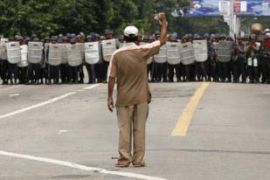Myanmar intensifies crackdown
Demonstrators defy machine-gun fire and beatings as international condemnation mounts.

However, protesters in Myanmar’s largest city repeatedly defied orders to disperse, constantly regrouping after each crackdown, witnesses said.
Rallies were also dispersed with teargas, baton charges and warning shots.
International condemnation
|
“The largely Buddhist population does revere their monks and they will not sit by idly while they are being beaten up” Kraut, Hamburg, Germany |
International condemnation of the government crackdown also grew, with the US demanding the military rulers “stop this violence against peaceful protesters now.”
The normally reticent Association of Southeast Asian Nations (Asean) expressed “revulsion” at the repression.
Asean foreign ministers said on Thursday they “were appalled to receive reports of automatic weapons being used and demanded that the Myanmar government immediately desist from the use of violence against demonstrators”.
Late on Thursday, Myanmar agreed that Nyan Win, the country’s foreign minister, would meet Ibrahim Gambari, the special envoy that the UN secretary-general has dispatched to the country.
Previous anti-government protests have seen thousands of saffron-robed monks march through the streets of Yangon.
The protesters have vowed to continue demonstrating against the military government, defying threats of further force after up to eight people were reported killed on Wednesday.
There have been few reports of demonstrations from other parts of the country, although previous days have seen protests in several towns and cities across Myanmar.
Monasteries raided
| Myanmar protests |
Thursday’s gathering came after government security forces launched pre-dawn raids on at least two monasteries in city of Yangon, beating several monks and arresting more than 70.
Windows at the Ngwekyaryan monastery in eastern Yangon were shattered and bloodstains, shards of glass and spent bullet casings littered the ground following the raid.
Unconfirmed reports said one monk had been killed overnight.
The opposition National League for Democracy, led by detained Nobel Peace laureate Aung San Suu Kyi, said that several of its senior members had also been arrested.
Wednesday’s crackdown on protesters drew international condemnation, with demonstrations being held outside Myanmar‘s embassies around the world and calls for tougher sanctions against the country’s leaders.
The violence has also raised fears of a repeat of the government’s ruthless suppression of the last major pro-democracy uprising, in which an estimated 3,000 people died.
China under pressure
On Thursday China, which has been under pressure to use its influence over the Myanmar government, called for calm from all sides.
 |
| Police fired on protesters who are calling for an end to military rule [AFP] |
“China hopes all parties can exercise restraint and properly handle the situation,” Jiang Yu, spokeswoman for the foreign ministry said.
She said foreign media reports risked “exaggerating and hyping up” the situation.
China is Myanmar‘s biggest diplomatic ally and its most important trading partner.
The government has admitted that one man was killed when police opened fire but dissidents outside Myanmar reported receiving news of up to eight deaths.
According to government statements on Wednesday’s violence, police used “minimum force” when a crowd of protesters refused to disperse and tried to grab weapons from officers.
An estimated 100,000 people joined Wednesday’s protests in Yangon – making it the largest turnout yet since the current wave of anti-government demonstrations began more than a month ago.
The protests, which were triggered by a sudden massive hike in the price of fuel, have become the biggest challenge to Myanmar‘s military rulers in almost two decades.

